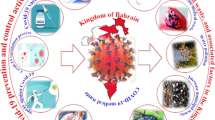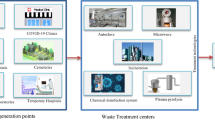Abstract
A hospital is a health care organization that provides services to treat the patient with specialized medical personnel, nursing staff with medicine, equipment and offers lifestyles-saving services to human beings. The hospital waste generated during the epidemic diseases like novel coronavirus disease (COVID-19) has led to an extra burden on the hospitals to control illness and significantly accelerated the biomedical waste generation rate. The abrupt spread of the COVID-19 virus has resulted in a significant increase in bio-medical waste, which has worsened the problem of medical waste management in India. In this study, the RIAM technique and sustainability model analysis the severity of COVID-19 on hospitals and compares the waste management practices of various hospitals before and during COVID-19. In addition, for comparing purposes, the environmental performance index is used in conjunction with RIAM scores. The Hospital "G" chosen as the most viable sustainability option during COVID-19, while Hospital "E" chosen as the most sustainable hospital in times prior to the COVID-19. The K Hospital is ranked worst of the hospitals surveyed in both before and during COVID-19. Only a few hospitals follow the biomedical waste management rules and COVID-19 guidelines for safe BMW management and the hospitals exert an extra load of waste due to epidemic conditions.


Similar content being viewed by others
Data availability
All data generated during the study appear in the published article.
References
Rawal N, Singh RM, Vaishya R (2011) Optimal management methodology for solid wastes in urban areas’. J Hazard Toxic Radioact Waste 16(1):26–38
Rawal N, Rai S, Duggal SK (2017) An approach for the analysis of the effects of solid waste management in slum areas by rapid impact assessment matrix analysis. Int J Environ Technol Manag 20(3–4):225–239
World Health Organization (2014) Safe management of wastes from healthcare activities, 2nd edn. WHO Press, Geneva
Nichols A, Grose J, Mukonoweshuro R (2016) Achieving cost and carbon savings in neonatal practice: a review of the literature on sustainable waste management. J Neonatal Nurs 22:81–87
Bio-Medical Waste Management (Amendment) Rules, 2018 Published in the Gazette of India, Extraordinary, Part II, Section 3, Sub-Section (i), Government of India Ministry of Environment, Forest and Climate Change. Notification;(March 2018).
World Health Organization (2019) Overview of technologies for the treatment of infectious and sharp waste from health care facilities. WHO
World Health Organization (2020) Coronavirus disease (COVID-19) Situation dashboard. Available at:https://who.sprinklr.com. Accessed 21 April 2020
Das S, Kumari R (2021) Statistical analysis of COVID cases in India. J Phys. https://doi.org/10.1088/1742-6596/1797/1/012006
Torres AL (2020) Practical guideline for the handling, storage and disposal of COVID-19 infected wastes, including personnel protective equipment.
Agrawal P, Kaur G, Kolekar SS (2021) Investigation on biomedical waste management of hospitals using cohort intelligence algorithm. Soft Comput Lett 3:100008
Bamakan SMH, Motavali A, Bondarti AB (2020) A survey of blockchain consensus algorithms performance evaluation criteria. J Expert Syst Appl 154:113385
Pastakia CMR (1998) The Rapid Impact Assessment Matrix (RIAM) – A new tool for environmental impact assessment. http://www.pastakia.com/riam/publication.html. Accessed 10 June 2023
Pastakia CMR, Jensen A (1998) The rapid impact assessment matrix (RIAM)for EIA. Environ Impact Assess Rev 18:461–482
Mohan S, Nair VV, Joseph CP (2017) Effective waste treatment and disposal by operating open dumpsites as bioreactors. Int J Adv Sci Eng Technol 5(3):19–22
Suthar S, Sajwan A (2014) Rapid impact assessment matrix (RIAM) analysis as decision tool to select new site for municipal solid waste disposal: a case study of Dehradun city India. Sustain Cities Soc 13:12–19
Rawal N (2019) An approach for selection of solid waste disposal sites by rapid impact assessment matrix and environmental performance index analysis. Int J Environ Pollut 66(1–3):127–142
Rawal N, Nidhi C, Pandey HK (2019) Rapid impact assessment matrix (RIAM)-based approach for selection of solid waste disposal site. Natl Acad Sci Lett. https://doi.org/10.1007/s40009-018-0765-4
Rawal N (2021) An approach for ranking of hospitals based on waste management practices by analytical hierarchy process (AHP) methodology. Proc Natl Acad Sci India Sect A. https://doi.org/10.1007/s40010-021-00760-x
Shrivastav RR, Rawal NR (2021) Approach for the assessment and ranking of hospitals based on waste management practices using RIAM, sustainability, and EPI techniques. J Hazard Toxic Radioact Waste 25:04020076. https://doi.org/10.1061/(ASCE)HZ.2153-5515.0000583
Ministry of Urban Development (MoUD) City Development Plan for Allahabad, 2041, Supported under Capacity Building for Urban Development project (CBUD) A Joint Partnership Program between Ministry of Urban Development, Government of India, 2015. http://allahabadmc.gov.in/documentslist/City_Development_Plan_Allahabad-2041.pdf
Acknowledgements
The authors would like to thank the Prayagraj Nagar Nigam (PNN), all the hospital employees, waste collection workers, experts, and the local people for help in data collection and survey during fieldwork.
Author information
Authors and Affiliations
Corresponding author
Ethics declarations
Conflict of interest
On behalf of all authors, the corresponding author states that there is no conflict of interest.
Additional information
Publisher's Note
Springer Nature remains neutral with regard to jurisdictional claims in published maps and institutional affiliations.
Appendix
Appendix



Rights and permissions
Springer Nature or its licensor (e.g. a society or other partner) holds exclusive rights to this article under a publishing agreement with the author(s) or other rightsholder(s); author self-archiving of the accepted manuscript version of this article is solely governed by the terms of such publishing agreement and applicable law.
About this article
Cite this article
Khaljhunia, N., Rawal, N. An approach for analysis of the effects of COVID-19 on ranking of hospitals based on waste management practices. J Mater Cycles Waste Manag 26, 1056–1070 (2024). https://doi.org/10.1007/s10163-023-01883-6
Received:
Accepted:
Published:
Issue Date:
DOI: https://doi.org/10.1007/s10163-023-01883-6




